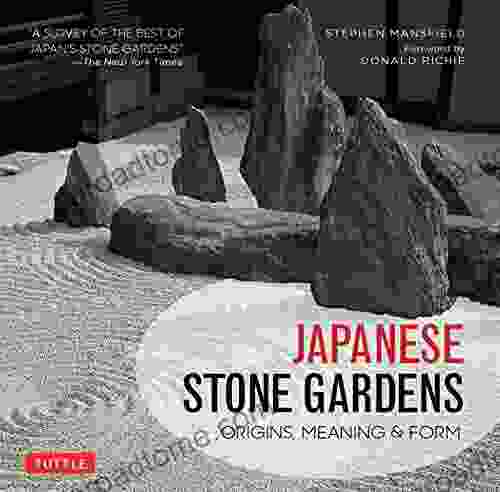Japanese Stone Gardens: Origins, Meaning, and Form

The origins of Japanese stone gardens can be traced back to the sixth century, with the of Buddhism to Japan. Early stone gardens were created by Buddhist monks as places for meditation and contemplation. These gardens were often simple and austere, consisting of a few rocks arranged in a bed of sand or gravel. 4.4 out of 5 Over time, stone gardens evolved and became more elaborate. By the 15th century, they had become a popular feature of Japanese architecture and landscape design. Stone gardens were often used to create a sense of peace and tranquility in temples, gardens, and palaces. Japanese stone gardens are more than just decorative features. They are imbued with a deep meaning and symbolism. The rocks in the garden represent mountains, islands, or other natural features. The sand or gravel represents water. The arrangement of the rocks and sand is carefully planned to create a harmonious and balanced composition. Stone gardens are often used for meditation and contemplation. The simple and serene nature of the garden helps to calm the mind and promote a sense of peace. The rocks and sand can also be used as a focus for meditation, helping to bring about a state of mindfulness. Japanese stone gardens are created according to a set of principles that govern their form and aesthetics. These principles include: The construction of a Japanese stone garden requires careful planning and execution. The rocks are carefully selected and arranged to create a harmonious and balanced composition. The sand or gravel is also carefully raked to create a smooth and even surface. The materials used in a stone garden are also important. The rocks are typically made of granite or other hard stone that will not deteriorate over time. The sand or gravel is usually made of fine-grained sand or gravel that will not create dust or dirt. Japanese stone gardens require regular care and maintenance to keep them looking their best. The rocks should be cleaned periodically to remove any dirt or debris. The sand or gravel should also be raked to maintain a smooth and even surface. Stone gardens are a beautiful and serene addition to any home or garden. With proper care and maintenance, they can provide a place for meditation, contemplation, and tranquility for years to come.Origins and History
Language : English File size : 75217 KB Text-to-Speech : Enabled Screen Reader : Supported Print length : 160 pages Meaning and Symbolism
Form and Aesthetics
Techniques and Materials
Care and Maintenance
4.4 out of 5
| Language | : | English |
| File size | : | 75217 KB |
| Text-to-Speech | : | Enabled |
| Screen Reader | : | Supported |
| Print length | : | 160 pages |
Do you want to contribute by writing guest posts on this blog?
Please contact us and send us a resume of previous articles that you have written.
 Book
Book Novel
Novel Page
Page Chapter
Chapter Text
Text Story
Story Genre
Genre Reader
Reader Library
Library Paperback
Paperback E-book
E-book Magazine
Magazine Newspaper
Newspaper Paragraph
Paragraph Sentence
Sentence Bookmark
Bookmark Shelf
Shelf Glossary
Glossary Bibliography
Bibliography Foreword
Foreword Preface
Preface Synopsis
Synopsis Annotation
Annotation Footnote
Footnote Manuscript
Manuscript Scroll
Scroll Codex
Codex Tome
Tome Bestseller
Bestseller Classics
Classics Library card
Library card Narrative
Narrative Biography
Biography Autobiography
Autobiography Memoir
Memoir Reference
Reference Encyclopedia
Encyclopedia Venus E Evans Winters
Venus E Evans Winters Tony Piedra
Tony Piedra Laura Berman
Laura Berman V Andrew Mcmillan
V Andrew Mcmillan Fonda Lee
Fonda Lee Thomas Ford
Thomas Ford Silvia Hagen
Silvia Hagen Wendy B Sharer
Wendy B Sharer Tom Isaacs
Tom Isaacs Steve Mayfield
Steve Mayfield Tiffany Kuhn
Tiffany Kuhn Wade Baskin
Wade Baskin Peter Macdonald
Peter Macdonald Scott Onstott
Scott Onstott Yacoub Binguitcha Fare
Yacoub Binguitcha Fare Manrico Erriu
Manrico Erriu Soli Shahvar
Soli Shahvar Larry Herzberg
Larry Herzberg Alain Danielou
Alain Danielou Robert Fleisher
Robert Fleisher
Light bulbAdvertise smarter! Our strategic ad space ensures maximum exposure. Reserve your spot today!
 Grant HayesFollow ·12.6k
Grant HayesFollow ·12.6k Vince HayesFollow ·5.2k
Vince HayesFollow ·5.2k Hugh ReedFollow ·10.5k
Hugh ReedFollow ·10.5k Cason CoxFollow ·11.2k
Cason CoxFollow ·11.2k Dalton FosterFollow ·9.6k
Dalton FosterFollow ·9.6k Ian PowellFollow ·13k
Ian PowellFollow ·13k George Bernard ShawFollow ·6k
George Bernard ShawFollow ·6k Gabriel Garcia MarquezFollow ·6.6k
Gabriel Garcia MarquezFollow ·6.6k

 Timothy Ward
Timothy WardSteamy Reverse Harem with MFM Threesome: Our Fae Queen
By [Author...

 Cody Blair
Cody BlairThe Ultimate Guide to Energetic Materials: Detonation and...
Energetic materials are a fascinating and...

 Kenzaburō Ōe
Kenzaburō ŌeProstitution, Modernity, and the Making of the Cuban...
By Emily A....

 Kirk Hayes
Kirk HayesUnveil the Enchanting World of The Rape of the Lock by...
Alexander Pope's epic...

 Ivan Turgenev
Ivan TurgenevTantric Quest: An Encounter With Absolute Love
Embark on a Tantric Quest to...

 Gary Reed
Gary ReedThe Darwin Awards: Evolution in Action
The Darwin Awards are a...
4.4 out of 5
| Language | : | English |
| File size | : | 75217 KB |
| Text-to-Speech | : | Enabled |
| Screen Reader | : | Supported |
| Print length | : | 160 pages |












